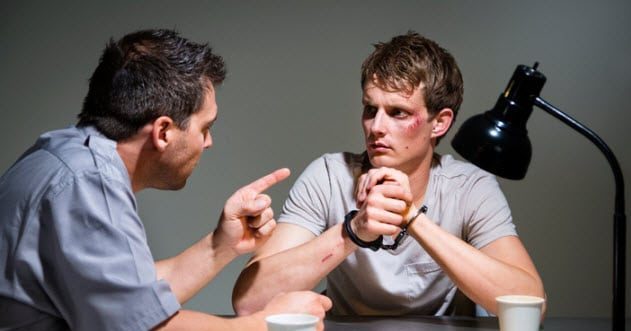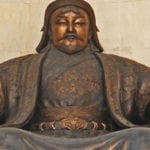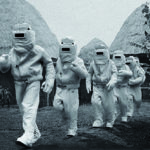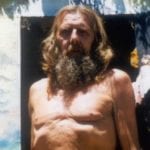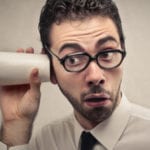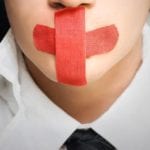 Weird Stuff
Weird Stuff  Weird Stuff
Weird Stuff  Animals
Animals 10 Inspiring Tales of Horses Being Human
 Mysteries
Mysteries Top 10 Haunting Facts About the Ghost Ship MV Alta
 History
History 10 Surprising Stories About the Texas Rangers
 Humans
Humans 10 Philosophers Who Were Driven Mad by Their Own Theories
 Miscellaneous
Miscellaneous 10 Video-Game-Worthy Weapons and Armors from History
 Weird Stuff
Weird Stuff 10 Psychics Who Accurately Predicted Wartime Events
 The Arts
The Arts 10 Pieces of Art Inspired by a Broken Heart
 Health
Health 10 Science Fiction-Sounding New Medical Treatments
 History
History 10 Surprising Facts About the Father of Submarine Warfare
 Weird Stuff
Weird Stuff 10 Times Real Laws Were Based on Bizarre Hypotheticals
 Animals
Animals 10 Inspiring Tales of Horses Being Human
 Mysteries
Mysteries Top 10 Haunting Facts About the Ghost Ship MV Alta
Who's Behind Listverse?

Jamie Frater
Head Editor
Jamie founded Listverse due to an insatiable desire to share fascinating, obscure, and bizarre facts. He has been a guest speaker on numerous national radio and television stations and is a five time published author.
More About Us History
History 10 Surprising Stories About the Texas Rangers
 Humans
Humans 10 Philosophers Who Were Driven Mad by Their Own Theories
 Miscellaneous
Miscellaneous 10 Video-Game-Worthy Weapons and Armors from History
 Weird Stuff
Weird Stuff 10 Psychics Who Accurately Predicted Wartime Events
 The Arts
The Arts 10 Pieces of Art Inspired by a Broken Heart
 Health
Health 10 Science Fiction-Sounding New Medical Treatments
 History
History 10 Surprising Facts About the Father of Submarine Warfare
Ten Things We Still Don’t Know About Lee Harvey Oswald
No, Lee Harvey Oswald wasn’t, per his infamous claim, a patsy. Instead, he was a killer—and overwhelming evidence supports this. By contrast, the endless conspiracy theories trying to take the smoking gun out of Oswald’s well-trained hands remain just that: theories.
But just because Oswald almost certainly committed the deadly deed himself doesn’t mean he did so, as the Warren Commission contends, entirely on his own. His odd life included limitless opportunities for outside influence by powerful players.
Here are ten questions about Oswald that remain unanswered—including, at #1, the most important mystery.
Related: 10 Assassinations That Went Horribly Wrong
10 How Could Someone So Incompetent Accomplish So Much?
Oswald’s brief biography—he died at 24—reads like a tale of two drastically different people. A strong argument that Oswald may not have killed the president on his own is this unanswered question: How could an all-time screwup commit the crime of the century?
The lowlights of Oswald’s life portray a lonely loser incapable of nearly anything. Jailed in juvenile detention for truancy, Oswald dropped out of school for good at 17, joining the U.S. Marines. There, he was court-martialed twice: first for fighting a superior officer, then for mistakenly shooting himself in the elbow.
The flip side? As a Marine, Oswald learned Russian, specialized in aviation electronics, and earned “sharpshooter” marksmanship status. Then, after tricking the military into a hardship discharge, he navigated logistical labyrinths to defect to the USSR.
When he returned, Russian wife in tow, he began writing but quickly abandoned a manuscript about his time in the USSR—possibly because he was an incredibly poor writer who misspelled even common words. He then quit or was fired from several menial jobs before landing a minimum-wage gig at the Book Depository in mid-October 1963.
Meanwhile, he cleverly created an alias, AJ Hidell, to clandestinely receive leftist literature and purchase his rifle, which he managed to conceal from his landlord and, on November 22, his carpool coworker.[1]
To many, the gulf between Oswald’s shortcomings and strengths requires a bridge too far. How could this pathetic fool have ended Camelot?
9 Why Did the U.S. Government Let Him Back In?
On September 11, 1959, Oswald received a hardship discharge from the U.S. Marine Corps after falsely claiming that his mother was ill. Nine days later, he boarded a ship to Europe. He lied to customs officials in the UK before flying to Helsinki, where he procured a Soviet visa.
The visa was for one week; he stayed for nearly three years.
When the Soviets refused to extend his visa, he made a semi-serious attempt at suicide by slashing his wrists. Soon, he visited the U.S. embassy in Moscow, where he voiced a desire to renounce his citizenship and reported his intentions to share information about his military experience with Soviet officials. This led the Marines to switch his discharge status from “hardship/honorable” to “undesirable.” Both the Associated Press and United Press International published stories detailing Oswald’s defection.
But despite Oswald’s erratic-at-best, treasonous-at-worst behavior, on June 1, 1962, the U.S. not only readmitted him and his mystery wife (who for all they knew could have been a spy) but also provided a repatriation loan of $435—more than $3,700 in today’s money.[2]
Why let someone so clearly unstable and un-American back into the USA? Baffling.
8 What Was Oswald Doing in New Orleans?
In late April 1963, Oswald abruptly returned to his hometown of New Orleans. Officially, it was to look for work to support his pregnant wife and young child. Unofficially, it was a convenient change of scenery after a high-ranking military officer had been nearly assassinated back in Dallas (more on that soon).
On May 10, Oswald was hired by the Reily Coffee Company to fill the glamorous role of machine greaser. But instead of working diligently to provide for his family—the entire (alleged) reason for his relocation—Oswald was fired just two months later because, per his boss, “his work was not satisfactory and he spent too much time loitering in Adrian Alba’s garage next door, where he read rifle and hunting magazines.” How industrious.
When not goofing off at work, Oswald was founding a chapter of the Fair Play for Cuba Committee in New Orleans. He spent hours on end handing out pro-Castro leaflets and getting into skirmishes with those who took exception. After the assassination, a member of a local anti-Castro group told investigators that Oswald had tried to infiltrate his organization.
Rumors abound about exactly who Oswald may have met down in the Big Easy, including a right-wing former FBI agent named Guy Bannister and local mobsters like Carlos Marcello and Sam Saia, for whom Oswald’s uncle was allegedly a bookie.[3]
7 And What Was He Doing in Mexico?
Two months before Kennedy’s killing, Oswald traveled from Texas to Mexico City. He arrived on September 27, departing on October 2.
At the time, Mexico City was a Cold War melting pot, among the Western Hemisphere’s only locales where every communist and democratic country had an embassy. It became a haven for both Soviet exiles and American leftists fleeing anti-communist persecution.
His first two days there, Oswald visited both the Cuban and Soviet embassies, attempting to secure visas. After being informed such documents would take months, he started a heated argument with Cuban diplomats and brandished a weapon at the Russian embassy before breaking down in tears.
For the next three-plus days, Oswald basically disappears.
For decades, a prominent source of Oswald’s whereabouts was Óscar Contreras, a reporter who claimed Oswald spent two days with a pro-Castro student group at Mexico’s National Autonomous University. Though Contreras’s account has since been legitimately called into question—he wrote a gossip column for a newspaper 300 miles away, so it’s unclear whether he was even in Mexico City—Oswald’s actions bring two possibilities to the forefront.[4]
First, if Oswald was actually desperate to flee either to Cuba or Russia…why? Did he know something foul was afoot and that he’d be caught up in it? Conversely, if all this was a ruse, exactly who did he meet with before returning to Dallas…and why?
6 Why Did Oswald Murder JFK?
The emphasis in the above question is on “JFK,” not “Oswald.” Again, hard evidence points to Oswald being the gunman. It’s also clear that Oswald was a skilled marksman capable of murder; following JFK’s death, Oswald’s widow told investigators her husband was responsible for an attempted assassination of General Edwin Walker in April 1963.
Walker was a right-wing, fervently anti-Communist war hawk—all anathema to Oswald’s Marxism, so his ill will toward the general is understandable. Kennedy, however—despite 1961’s ill-fated Bay of Pigs invasion—was far more moderate. Oswald’s questionable motive has left many believing he was merely the triggerman for a broader plot by the CIA, mafia, or even Fidel Castro.
Of course, one thing JFK presented to Oswald was an easy target. Once the motorcade route was published before the president’s arrival, Oswald learned the most powerful man in the world would be making a slow, sharp turn just yards from his workplace.
The best answer to “Why JFK?” then becomes a combination of opportunity and ego (many believe Oswald had a personality disorder that made him fantastically grandiose). But if Oswald wanted to cement his legacy, why did he refuse to confess to the assassination—even when near death?
Two days after the assassination—himself the victim of an assassin—Oswald was repeatedly asked by police detective Billy Combest if he wanted to confess. Oswald refused each time, then died, leaving generations of conspiracy theorists to doubt his place in history.[5]
5 What Happened to His First Shot?
Ballistics tests, reenactments, and geometry strongly support the so-called “Magic Bullet” theory. This was Oswald’s second shot, which entered JFK’s upper back, exited his neck, and caused several wounds to Texas Governor John Connally. Oswald’s third and final shot, of course, was the fatal headshot.
That leaves one shot unaccounted for—well, partially anyway. Bystander James Tague, near the famed triple underpass—ahead of the motorcade when the shooting occurred—received a wound to his cheek, caused by a bullet fragment or chunk of curb impacted by the bullet. The bullet itself was never found.
By process of elimination, this was the first shot, fired just as or shortly after JFK’s limousine turned from Houston Street onto Elm Street (and yes—that’s where Nightmare on Elm Street gets its name). This is earlier than many experts believe, expanding the time between the first and final shots from six seconds to about ten.
A 2011 documentary, JFK: The Lost Bullet, suggests the shot ricocheted off an obstruction, eventually striking the curb and wounding Tague. It’s a strong THEORY, but no slam dunk. A tree obscuring Oswald’s view bore no bullet marks; ditto for an adjacent traffic light pole. And though the film discovered, via FBI reenactment footage, what seems like a bullet hole on the traffic signal itself (the signal has since been replaced), the filmmaker later dismissed this idea due to the brittleness of its material (found at 58:30 into the video).[6]
4 Why Wasn’t Oswald Seen or Heard on the Stairs?
From the fourth-floor stockroom of the Texas School Book Depository, Victoria Elizabeth Adams saw JFK shot. According to her Warren Commission testimony, she was watching the motorcade pass from a window along with three other colleagues when the rifle reports rang out.
Immediately after the third shot, Adams and a coworker, Sandra Styles, headed downstairs. They took the only staircase leading from her area of the building. Per the official account of the assassination, Oswald descended this very same staircase—from two stories higher—just after the shooting, reaching a second-floor breakroom less than 90 seconds later. There, he was encountered and momentarily questioned by Dallas police officer Marrion Baker, who confirmed that he was employed in the building (and therefore unsuspicious) before continuing in pursuit of the gunman.
Not only did Adams and Styles not see Oswald rushing past them, but they also didn’t hear anyone directly above or below them, despite the old, creaky wooden stairs that were traipsing. Adams also noted that the elevator wasn’t moving—she could tell because the cables weren’t moving, and the telltale mechanical whir wasn’t evident.
A 2011 book, The Girl on the Stairs, documents Adams’s story and posits that, since her timeline of events conflicts with the Warren Commission’s official account, her testimony was largely ignored despite being backed up by several coworkers.[7]
3 Why Didn’t Oswald Pay for His Movie Ticket at the Theater Where He Was Arrested?
According to the Warren Commission, following the assassination, Oswald slipped out of the Book Depository, walked several blocks, caught a bus, then took a taxi to his boarding house, where he grabbed a pistol and coat.
He proceeded to 214 W. Neely Street, in the same neighborhood, where his semi-estranged wife lived with their young children and landlord Ruth Payne. Oswald was next spotted a mile away, where a police officer, J.D. Tippit, stopped him for fitting the description of JFK’s assassin. Oswald shot and killed him; the murder was witnessed by at least a dozen people, five of whom identified Oswald in a subsequent lineup.
From there, Oswald made haste toward Jefferson Boulevard, a major thoroughfare. He ditched his coat along the way, then ducked in and out of businesses’ recessed doorways as police cars whizzed past, sirens blaring. A shoe store manager, Johnny Calvin Brewer, noticed the suspicious behavior and followed Oswald for several blocks.
Then a man resourceful enough to make it that far did something inexplicable: he walked into the Texas Theatre movie house without paying for a ticket. While it’s likely he would have been apprehended there anyway—Brewer saw him enter the theater and hailed a police car—why would a man trying to evade police after murdering a police officer (let alone the president) risk his cover being blown by a ticket agent?[8]
2 Why Did Jack Ruby Kill Oswald?
On Sunday, November 24, the most incredible weekend in the young history of broadcast journalism took a final macabre turn. At 12:20pm, the president’s alleged assassin was shot and killed in the basement of the Dallas police headquarters. The slaying played out on network television—the first murder ever broadcast live.
To accomplish this, Ruby snuck into the basement when a guard left his post to stop traffic so a police convoy could transport Oswald to county jail. The area was filled with reporters and camera crews, allowing Ruby to blend in wearing a simple suit and hat. Still, the police’s inability to safeguard a man many wanted lynched is unbelievably incompetent—inviting theories of a conspiratorial coverup to permanently silence Oswald.
The other question was Ruby’s motive, especially considering he had zero chance of escaping arrest. Ruby cited rage at Kennedy’s murder and a desire to spare Jackie Kennedy the stress of Oswald’s trial as a motive. Supporting Ruby’s story is his penchant for violence; he was known to physically abuse his nightclub employees when angered. Ruby’s attorney also argued that he’d suffered an epileptic seizure and shot Oswald in the throes of an altered state.
However, Ruby also was heavily in debt, arousing suspicion that outside influence—the mob, perhaps—forced him to slay Oswald, choosing life in jail over being murdered by the mafia. Ruby died in prison in 1967.[9]
1 So…Did Oswald Have Help?
The most haunting open question in the history of American crime is whether Lee Harvey Oswald assassinated an enormously consequential president entirely on his own—or whether he was a tool of far more powerful forces.
On the one hand, Oswald fits the description of a lone nut—an angry egomaniacal weirdo who, despite disgrace and destitution, thought too much of himself. Perhaps the reason so many refute Oswald’s sole culpability is because they don’t want to believe someone so insignificant could snuff out someone so monumental.
But on the other hand, those same qualities made Oswald exceptionally manipulatable to the right people—and JFK certainly had enemies. Several prominent members of the military and intelligence agencies disliked Kennedy vehemently; for example, CIA higher-ups never forgave JFK for refusing air cover during the disastrous Bay of Pigs Invasion, for which the agency both planned and trained Cuban exiles. That very same incident, of course, also gave Cuban dictator Fidel Castro sound reason—revenge—to want JFK dead.
And then there’s the mob. JFK’s brother and U.S. Attorney General, Robert Kennedy, had led a highly publicized crusade against the American mafia. And seedy nightclub owner Jack Ruby—the man who silenced Oswald forever—undoubtedly rubbed elbows with goodfellas.[10]
We’ll never truly know whether the smirking, self-satisfied Oswald was the director of this American tragedy or merely its final actor. And that’s the toughest question of all.
